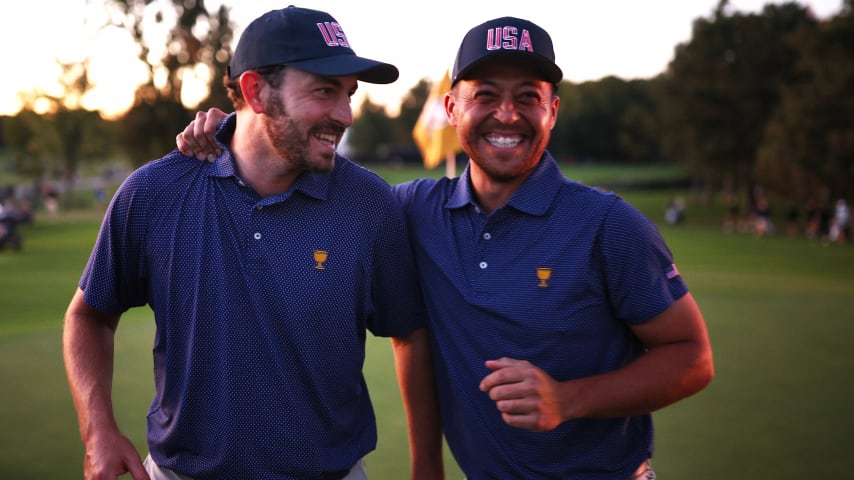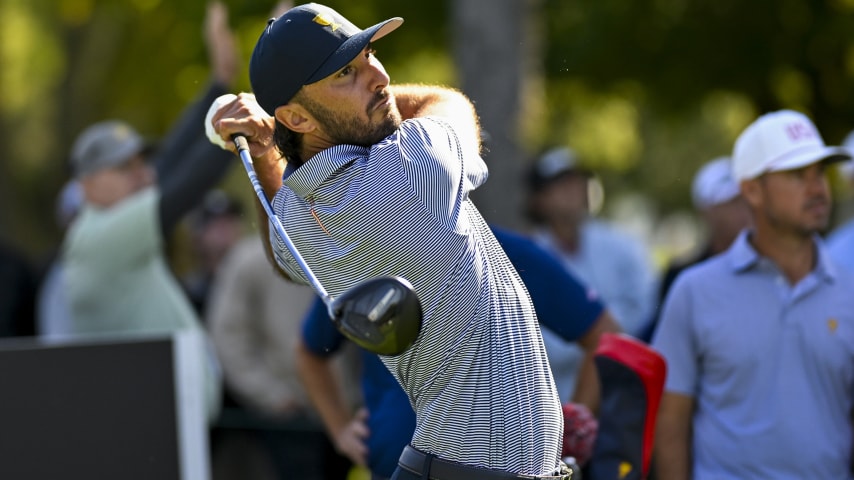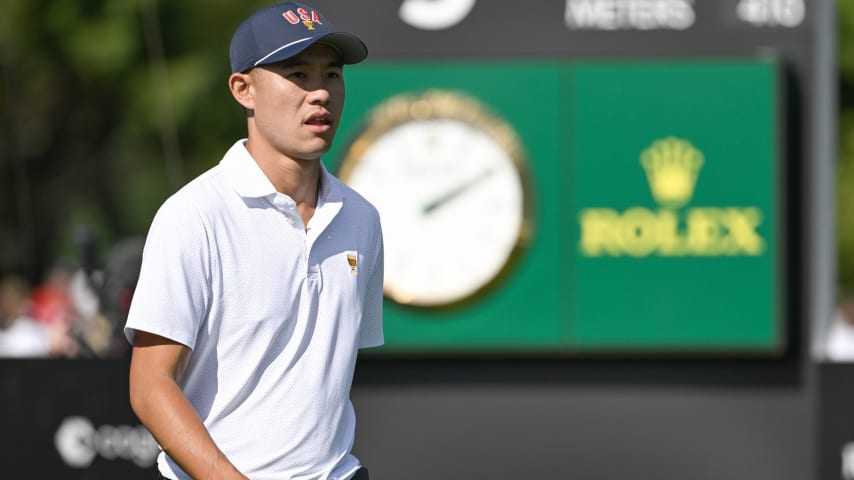Cohesive core leads U.S. to Presidents Cup victory
8 Min Read

U.S. Team secures emotional win at Presidents Cup
Written by Sean Martin
MONTREAL – Jim Furyk saw the signs well before his team arrived in Canada for the Presidents Cup. There were clues more than a month ago in Memphis, Tennessee, when his top players said they wanted to arrive at the Presidents Cup earlier than any U.S. Team ever had. He saw more examples on Friday night, after the United States’ worst session in this event’s history, and again when the team walked on the bus before sunrise the next morning. And, most importantly, he saw that leadership when he threw his top players into stressful situations, when they needed to summon their best to keep the International Team at bay.
“I have some great leaders on this team, and those guys took command,” Furyk said as he stood on Royal Montreal’s 18th green, moments after Keegan Bradley collected the clinching point. “They took control of the team.”
For all the criticism that is lobbed at U.S. squads – that the individualistic Americans struggle to assimilate to a team culture – Furyk insists that his top players set a different tone this week, both with their words and their play. His best players were also his best leaders, something that can’t be said about every American roster over the years.
There were moments during the United States’ 18.5-11.5 win this week at Royal Montreal Golf Club where the momentum shifted and things could have easily gone awry. That’s when Furyk’s core was at its best, with a strong, calming presence in the team room and the gravitas to score points when they were needed most.
“We talked about being a dog all week, being the tougher team,” Furyk said.
They were, quickly quashing any International uprisings and flipping matches on the final holes. Furyk leaned heavily on his stars, and they delivered.
This U.S. roster featured three of the top four players in the world – Scottie Scheffler (No. 1), Xander Schauffele (No. 2) and Collin Morikawa (No. 4). That trio played in every session, as did Patrick Cantlay, the world’s ninth-ranked player. Schauffele, Cantlay and Morikawa all went 4-1, while Scheffler, winless in the previous two Cup competitions, was 3-2.
“I didn't grow up playing team sports, so it's important, I think, for a team to be cohesive and to get along and to laugh, at least in my eyes,” said Schauffele.
This U.S. Team was coming off a rout in last year’s Ryder Cup in Rome, but it was willing to implement lessons learned from that loss, even if it meant sacrificing valuable downtime after a long season. Last year, the U.S. was tired and unprepared after taking an overnight flight that landed in Italy on the Monday of tournament week. The U.S. Team that Furyk captained in 2018 was hurt by a similar itinerary. Determined not to repeat that mistake, the players on this Presidents Cup team came to Canada last Saturday, an unprecedented arrival date that will likely become standard operating procedure.
It gave the players more time to prepare during a week when their schedules are not their own, putting less pressure on them to cram their prep in between team pictures and gala dinners. It also helped Furyk, who said he was a half-step ahead of where he was in 2018, feel more prepared. That helped his team have more confidence in his decisions. The pairings for team sessions, which are always overanalyzed and given outsized credit for a team’s success or failure, were formed even earlier, almost from the outset of the team’s formation.
“When the picks were made, … the pairings were already kind of in place,” Furyk said.
That also was much earlier than in his last captaincy. But he also credited his team for its flexibility. The players were open to new pairings that unlocked points from new sources and got the most out of the team's stars. Such willingness to set aside preferences in partners hasn’t always been present on U.S. teams.
After going 1-5-2 in his previous two Cup competitions, Sam Burns, a Southerner from small-town Louisiana, successfully paired with a couple of Californians (Cantlay, Morikawa) to be the only undefeated player on either team (3-0-1). Russell Henley went 3-1-0 while playing the team sessions alongside Scheffler, who once had been Burns’ regular partner. Henley, 35, was one of just two Americans making his first appearance as a pro in international team competition (Sahith Theegala was the other).

U.S. Team Captain Jim Furyk's interview after winning the Presidents Cup
This U.S. roster featured eight players from last year’s Ryder Cup team, but only five players from the team that authored a record-setting rout at Whistling Straits three years earlier (Scheffler, Morikawa, Cantlay, Schauffele and Tony Finau). Scheffler and Morikawa were making their U.S. debuts that week, while Cantlay and Schauffele were playing in just their second international competition. The ensuing years formed them into an important core for Furyk’s team.
“Maybe they’re not the rah, rah, not the loudest guys, but those guys stepped up when it was needed to be said and done,” Furyk said.
This was Scheffler’s third time representing the United States as the No. 1 player in the world, but the first time he won any matches while holding that position. His winning record at Royal Montreal was more appropriate for a player who’d won eight times in 2024, including the Masters, THE PLAYERS, the FedExCup and Olympic gold medal.
Schauffele played like the two-time major winner that he became this year, rebounding from a 1-3-0 showing in Rome. Morikawa, who was in the midst of a two-year winless drought at last year’s Ryder Cup, also went 1-3-0 last year. But he arrived in Montreal after a consistent 2024 where he matched his career-high in top-10s, finished second to Scheffler in the FedExCup and returned to the top five in the world ranking. And Cantlay, who entered this week with an 11-5-1 record in international team competition, continued his match-play success. His 17-foot birdie putt on Saturday, the United States’ final stroke of the day, gave the Americans a four-point lead entering Singles.
Those four were integral when the U.S. Team arrived at the hotel a night earlier, after the International Team had responded to the United States’ Thursday sweep with one of its own. The fact that the Internationals won all five of Friday’s matches in the Foursomes format, which the U.S. has traditionally dominated in this event, made the result even more disconcerting.
“Friday night could have been a little bit of a panic,” Furyk said. “It was a very calm night and very much, ‘Let’s right the ship and get out there.’ We were on the bus at 4:15 (Saturday morning), but … the looks getting on and off the bus, I was excited about getting out on the golf course.”
To stem any International momentum, Furyk started Saturday with his top players at the front of the lineup.
Furyk had said previously that he wouldn’t pair Scheffler and Schauffele together, not wanting to repeat Hal Sutton’s mistake from the 2004 Ryder Cup. There’s too much risk putting the world’s top two players in the same match. Furyk did the next best thing, though.
He paired Scheffler and the fourth-ranked Morikawa. Scheffler birdied 16 and 17 to give his team a 2-and-1 victory that ended the Internationals’ winning streak. Schauffele played with Finau in the day’s second match; they beat Canada’s Corey Conners and Mackenzie Hughes, 3 and 2.
The U.S. may have won both Saturday sessions, 3-1, but there was a time Saturday afternoon where another International comeback seemed afoot. The home team held at least a 2-up lead in three of the four afternoon matches, and was tied on the back nine in the other. But the U.S. overcame the spirited play of Tom Kim and Si Woo Kim, the steady execution of Hideki Matsuyama and Sungjae Im and the short-game magic of Mackenzie Hughes.

Tom Kim and Si Woo Kim electric moments from Day 3 at Presidents Cup
Scheffler and Henley were 3-down through six holes of their match and still 1-down through 11, but they won four of the next five holes to beat Hideki Matsuyama and Sungjae Im, 3 and 2. Morikawa and Burns overcame a Mackenzie Hughes hole-out from the sand, and his 11-foot birdie putt to tie on 16, to win 1-up. And then Cantlay, with the American’s final stroke in the darkness of Saturday night, holed that 17-footer that gave him a 1-up win with partner Xander Schauffele and added another point to the Americans’ advantage.
“They kicked a lot of ass out there,” Furyk said. “When it got tough, anytime the Internationals put some pressure on us, they played their asses off for us.”
Furyk also top-loaded his Singles lineup to end things early. He led with Schauffele, Burns, Scheffler, Henley and Cantlay. They delivered 3.5 of a potential five points after Schauffele, Henley and Cantlay won their matches and Burns added a tie. The clinching point was poetically secured by Keegan Bradley, who will captain next year’s Ryder Cup team. He was in the day’s sixth match, rendering the second half of the Singles matches meaningless.
“We're going to copy a lot of what Jim Furyk did this week,” Bradley said. “He set a culture here for us, and we're going to carry that over into Bethpage.”
He’ll lean on a core that played an invaluable role at Royal Montreal.












